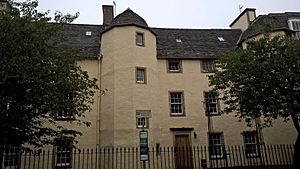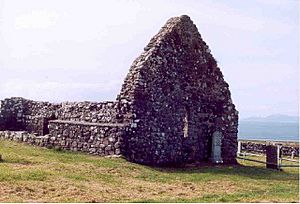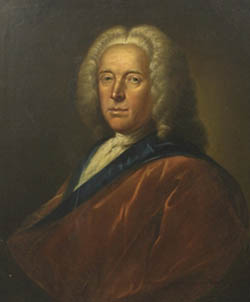Rachel Chiesley, Lady Grange facts for kids
Quick facts for kids
Rachel Chiesley
|
|
|---|---|
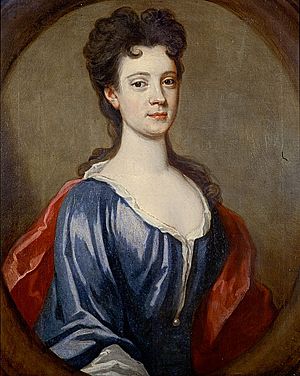
Portrait of Lady Grange by Sir John Baptiste de Medina c. 1710
|
|
| Born | 1679 |
| Died | 12 May 1745 (aged 66) Trumpan, Skye, Inverness-shire, Scotland
|
| Known for | being kidnapped |
| Title | Lady Grange |
| Spouse(s) | James Erskine, Lord Grange |
| Children | Charlie, Johnie, James, Mary, Meggie, Fannie, Jeannie, Rachel, John |
| Parent(s) | John Chiesley of Dalry and Margaret Nicholson |
Rachel Chiesley (born in 1679 – died 12 May 1745), also known as Lady Grange, was married to Lord Grange. He was a Scottish lawyer who supported the Jacobite cause, which wanted a different royal family to rule Britain.
After 25 years of marriage and having nine children, the Granges had a very difficult separation. Lady Grange found letters she said proved her husband was secretly working against the government. Because of this, her husband had her kidnapped in 1732. She was held captive in many faraway places in Scotland, including the Monach Isles, Skye, and St Kilda.
Lady Grange's father had been found guilty of murder. She was also known to have a strong temper. At first, her disappearance did not cause much concern. But eventually, news of her situation reached her hometown of Edinburgh. Her lawyer, Thomas Hope of Rankeillor, tried to rescue her, but he was not successful. She died after being held captive for over 13 years. Her story has been told in poems, books, and plays.
Contents
Her Early Life
Rachel Chiesley was one of ten children. Her parents were John Chiesley of Dalry and Margaret Nicholson. Her parents' marriage was not happy. Her mother even took her father to court for financial support.
Her father, John Chiesley, was very angry about the court's decision. On 31 March 1689, he shot a judge named Sir George Lockhart on the High Street in Edinburgh. This happened as the judge was walking home from church. John Chiesley did not try to run away and admitted what he had done. He was executed two days later. Rachel Chiesley was about ten years old when this happened.
Marriage and Family
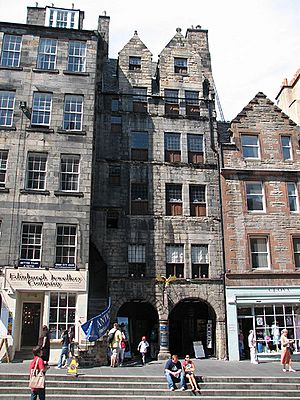
We are not sure exactly when Rachel Chiesley married James Erskine. It might have been in 1707, when she was about 28 years old. James Erskine was the younger son of Charles Erskine, Earl of Mar. His older brother, John Erskine, became the Earl of Mar in 1689.
This was a time of political trouble in Scotland. Many people supported the Jacobite cause, which wanted to bring back the old royal family. James's brother, the Earl of Mar, was involved in a rebellion in 1715. Because of this, he lost his title and had to leave Scotland.
Lord and Lady Grange lived a seemingly normal family life. They spent time at their house in Edinburgh and on an estate in Preston. Lady Grange even managed the Preston estate for a while. Her husband was a successful lawyer. He became a high-ranking judge in 1710. They had nine children:
- Charlie, born August 1709.
- Johnie, born March 1711, died at two months old.
- James, born March 1713. He married his uncle John's daughter, Frances. Their son John later became Earl of Mar.
- Mary, born July 1714. She married John Keith, the 3rd Earl of Kintore, in August 1729.
- Meggie, who died young in May 1717.
- Fannie, born December 1716.
- Jeannie, born in December 1717.
- Rachel.
- John.
Lady Grange also had two miscarriages. One of their children died in 1721.
Problems and Separation
There were clearly many problems in the Erskines' marriage. These problems eventually became public. Around 1717 or 1718, a tutor for their children wrote that Lady Grange had a "difficult temper." Her angry outbursts sometimes scared her younger daughters.
After Lady Grange was kidnapped, none of her children tried to help her. The oldest children would have been in their early twenties at the time. One writer, Macaulay, suggests that the family's calm reaction to their mother's disappearance made others think it was not a big deal. This might have been because Lady Grange had previously removed all her children from her will when they were very young.
As their marriage got worse, Lady Grange's actions became harder to predict. In 1730, she lost her role as manager of the Preston estate. This made her even more upset. She also found out her husband was having a relationship with a coffeehouse owner named Fanny Lindsay. This made things much worse.
Lady Grange signed a formal separation agreement from James Erskine on 27 July. But things did not get better. She would shout at her husband in the street and in church. Once, he and one of their children had to hide from her in a tavern for hours. She also found one of his letters and took it to the authorities. She claimed it proved he was working against the government. She was also said to have stood outside their house, waving the letter and shouting. In January 1732, she planned to travel to London. James Erskine and his friends were afraid she would cause more trouble there. They decided they had to act.
The Kidnapping

Lady Grange was taken from her temporary home in Edinburgh on the night of 22 January 1732. Two Highland leaders, Roderick MacLeod of Berneray and Macdonald of Morar, along with their men, carried out the kidnapping. There was a struggle, and she lost several teeth. She was blindfolded and taken out of the city in a covered chair.
They traveled north, then west on horseback. She was held at a house near Linlithgow for one night. Next, she was taken north to Wester Polmaise near Falkirk. She was kept there until 15 August in an empty tower. By this time, she was over fifty years old.
From Polmaise, Peter Fraser, a helper of Lord Lovat, and his men took her west through Perthshire. In Balquhidder, she was given a meal and a place to sleep. The area had a pool called St Fillan's Pool, which was used to treat mental illness. This might have been a good cover story for her captors if anyone asked about her. The exact path after this is not clear. But she was likely taken through Glen Coe to Loch Ness, then through Glen Garry to Loch Hourn on the west coast.
After a short wait, she was put on a ship to Heisker, the main island of the Monach Isles. She must have quickly realized how difficult her situation was. She was with men who were loyal to clan leaders, not the law. Few of them spoke English. Their native Gaelic language would have been impossible for her to understand. However, as her captivity continued, she slowly learned some Gaelic. She complained that young local nobles visited her at Loch Hourn. She said they came "to see me, but not to relieve me."
Monach Isles
The Monach Isles, also called Heisker, are about 8 kilometers (5 miles) west of North Uist. These islands are part of the Outer Hebrides, a group of islands off Scotland's west coast. The main islands are Ceann Ear, Ceann Iar, and Shivinish. They are all connected at low tide. The islands are flat and fertile. About 100 people may have lived there in the 1700s.
At that time, the islands belonged to Sir Alexander MacDonald of Sleat. Lady Grange stayed with his tenant, another Alexander MacDonald, and his wife. When she complained about her living conditions, her host told her he had no orders to give her special clothes or food. She lived alone for two years. She was not even told the name of the island where she was living. It took her some time to find out who owned the land.
She stayed there until June 1734. Then, John and Norman MacLeod from North Uist arrived to move her. They told her they were taking her to Orkney. But instead, they sailed to the very remote islands of St Kilda.
St Kilda
One of the sad ruins on the island of Hirta in the St Kilda archipelago is said to be the site of Lady Grange's House. This "house" is actually a large cleit, which is a stone storage hut. Some people believe it was rebuilt on the site of a larger traditional house where she lived.
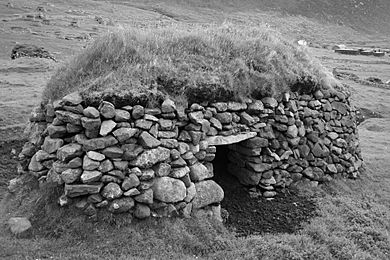
Hirta is even more remote than the Monach Isles. It lies about 66 kilometers (41 miles) west-northwest of Benbecula in the North Atlantic Ocean. Life on St Kilda was very isolated. In the late 1600s, the only way to get there was by open boat. This journey could take days and was almost impossible in autumn and winter. Even on calm days, landing on the slippery rocks could be dangerous. Because of the distance and weather, the people living there knew very little about the rest of the world.
Lady Grange's situation was even more uncomfortable here. No one on the island spoke English. She described Hirta as "a vile, nasty, stinking poor Isle." She said, "I was in great misery in the Husker but I'm ten times worse and worse here." Her living place was very basic. It had a dirt floor, rain ran down the walls, and in winter, snow had to be scooped out from behind her bed. She spent her days sleeping, drank a lot of whisky, and walked the shore at night, feeling sorry for herself.
While on Hirta, she wrote two letters telling her story. These letters eventually reached Edinburgh. One, dated 20 January 1738, reached her lawyer, Thomas Hope of Rankeillor, in December 1740. Some stories say the first letter was hidden in yarn and sent to Edinburgh. However, other sources say both letters were secretly taken off Hirta by Roderick MacLennan, the island's minister.
No matter how it arrived, the letter caused a stir in Edinburgh. But James Erskine's friends managed to stop Hope from getting a warrant to search St Kilda. In her second letter, Lady Grange complained about Lord Lovat and Roderick MacLeod. She also mentioned being called "the cargo" by Sir Alexander MacDonald. Hope had known Lady Grange was taken from Edinburgh but thought she would be well cared for. He was shocked by her condition. He paid for a small ship with twenty armed men to go to St Kilda. The ship sailed by 14 February 1741, but it was too late. Lady Grange had already been moved from the island, probably in the summer of 1740.
After a battle in 1746, there were rumors that Prince Charles Edward Stuart had escaped to St Kilda. British soldiers went to Hirta to search. They found an empty village because the St Kildans had hidden in caves, fearing pirates. When the villagers were convinced to come out, the soldiers found that these isolated people knew nothing about the Prince. They had never even heard of King George II. It's interesting that Lady Grange's letters and her move from the island might have stopped her from being found by this search party.
Skye
By 1740, Lady Grange was 61 years old. After being quickly removed from St Kilda, she was taken to different places in the Scottish Highlands. These included possibly Assynt in mainland Scotland and the Outer Hebridean islands of Harris and Uist. She finally arrived at Waternish on Skye in 1742.
Local stories suggest she might have been kept for 18 months in a cave. This cave could have been at Idrigill or on the Duirinish coast. She was later housed with Rory MacNeil at Trumpan in Waternish. She died there on 12 May 1745. MacNeil buried her "properly" the following week in the Trumpan churchyard. Other sources say she died in a small cottage at Idrigill in June 1749.
For unknown reasons, a second funeral was held nearby in Duirinish later. A large crowd gathered to watch the burial of a coffin filled with dirt and stones. Some people say this was her third funeral, with Lord Grange having held one in Edinburgh after her kidnapping. However, this story first appeared in writing in 1845, and there is no other proof that it is true.
Why Did This Happen?
Lady Grange's story is very unusual. There are many questions about it. Why did James Erskine go to such extreme lengths? Why were so many people willing to help with this illegal kidnapping? And how was she held for so long without being rescued?
The first two questions are connected. Erskine's brother had already been sent away for supporting the Jacobites. Simon Fraser, Lord Lovat, who was a key person in Lady Grange's kidnapping, was later executed for his part in another Jacobite rebellion. There is no strong proof that Erskine was plotting against the government. But any threat of this information getting out, whether true or not, would have been taken very seriously. This made it easy for Erskine to find helpers among the Highland gentry.
James Erskine himself was a mix of good and bad qualities. Besides his legal work, he was elected to Parliament in 1734. He managed to avoid trouble during the Jacobite rebellions. He was also very religious. This last quality might have stopped him from having his wife killed. He did not marry his long-time partner, Fanny Lindsay, until he heard about Lady Grange's death.
The main reason no one rescued Lady Grange was how remote the Hebrides were in the early 1700s. There were no good maps of the area until 1776. Without local help and knowledge, finding a captive in this wild area would have needed a large search party. Still, it is surprising that Edinburgh society and her own children did not do more to get her back. For example, the Church of Scotland could have easily contacted her or shared news of her condition. But they did not. It seems that John Chiesley's daughter did not have many people in her hometown who felt sorry for her.
One writer, Margaret Macaulay, suggests that how women were seen in the 1700s played a big role. Many documents from Lord Grange's friends still exist, but there are no writings from any other women about the situation, except for Lady Grange herself. Divorces were complicated, and mothers rarely got to keep their children. Also, Lord Grange had powerful friends in the church and law, which would have made it risky to challenge him.
As for Lady Grange, her angry outbursts and drinking clearly played a part in her downfall. One person described her as "stormy and outrageous." But it was also in her husband's interest to make her emotions seem worse than they were. Rachel threatened to tell people that her husband supported the Jacobites. Perhaps she did not understand how serious this accusation was. She might not have known how dangerous it was for her husband and his friends, or how determined they would be to protect themselves.
In Books and Art
Rachel Chiesley's story has inspired many creative works. These include:
- A romantic poem called "Epistle from Lady Grange to Edward D— Esq" by William Erskine in 1798.
- A novel from 1905 called The Lady of Hirta, a Tale of the Isles by W. C. Mackenzie.
- A poem by Edwin Morgan in 1984 called "Lady Grange on St Kilda."
- The Straw Chair, a play by Sue Glover, first performed in Edinburgh in 1988. It is about her time on St Kilda.
- Burdalane, a play by Judith Adams performed in 1996.
- Andrew Drummond's fantasy novel The Books of the Incarceration of the Lady Grange (2016).
- Sue Lawrence's novel The Unreliable Death of Lady Grange (2020).
Boswell and Johnson talked about Lady Grange during their 1773 trip to the Hebrides. Boswell wrote that Dr. Johnson joked that if the local chief, MacLeod, let it be known he had a place for "naughty ladies," he could make St Kilda a very profitable island.
There are portraits of both James Erskine and Rachel Chiesley in the Scottish National Portrait Gallery in Edinburgh. When writer Margaret Macaulay looked for them, she found they had been placed together in the same cold storage room.
See also
- Queen Joanna of Castile, a 16th-century queen who was said to be mentally ill and held captive. This might have been because others wanted to control her kingdom.
- Lisbeth Salander, a made-up character from a book series. She is declared mentally unwell by people trying to control her.
- List of kidnappings


